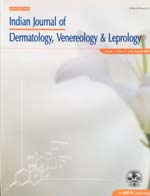
|
Indian Journal of Dermatology, Venereology and Leprology
Medknow Publications on behalf of The Indian Association of Dermatologists, Venereologists and Leprologists (IADVL)
ISSN: 0378-6323
EISSN: 0378-6323
Vol. 76, No. 6, 2010, pp. 723-723
|
 Bioline Code: dv10219
Bioline Code: dv10219
Full paper language: English
Document type: Study
Document available free of charge
|
|
|
Indian Journal of Dermatology, Venereology and Leprology, Vol. 76, No. 6, 2010, pp. 723-723
| en |
Coexistence of onychomycosis in psoriatic nails: A descriptive study
Natarajan, Vidhya; Nath, Amiya Kumar; Thappa, Devinder Mohan; Singh, Rakesh & Verma, Surendra Kumar
Abstract
Background: Psoriatic nail changes predispose to onychomycosis because it becomes easier for fungi to penetrate an already compromised nail plate. Moreover, some of the psoriatic nail changes closely resemble onychomycosis. Aim: To investigate cases of nail psoriasis for any evidence of onychomycosis. Methods: Seventy-two patients with psoriasis were included in the study. The patients were selected from the psoriasis clinic and dermatology in-patient ward. Direct microscopic examination with 20% KOH and culture were carried out in all patients showing psoriatic nail changes. Histopathological examination with Periodic Acid-Schiff (PAS) stain was done in cases negative by KOH examination and culture. Results: Nail changes were seen in 66.66% (48/72) of psoriasis patients. The most common fingernail changes observed were pitting, onycholysis and subungual hyperkeratosis, and the most common toenail changes were onycholysis and subungual hyperkeratosis. Nail changes were significantly more common in males. The duration of skin lesions of psoriasis and Psoriasis Area Severity Index scores were significantly higher in patients with nail changes. Out of 48 patients with psoriatic nail change, 23 (47.91%) had investigative evidence of onychomycosis. The fungal isolates on culture were non-dermatophytic molds in nine patients (18.75%) and yeast like fungi also in nine patients (18.75%). Conclusion: Coexistent onychomycosis in psoriatic nails does occur.
Keywords
Nail changes, onychomycosis, psoriasis
|
| |
© Copyright 2010 Indian Journal of Dermatology, Venereology, and Leprology.
Alternative site location: http://www.ijdvl.com
|
|
